On The Road Part I
Once your trip is under way, the rules and the skillsets change. Adaptation, response, and improvization combine to make up the new order. Unfortunately, all too typically these are first brought into play because of something left behind. Experienced travelers know better than to expect total efficiency in their own preparation, and instead allow for a logistical gap in the packing list.

Travel photography and spontaneity
Travel photography is concerned with how things actually are, with a strong dose of documentary. But quite often events are openly staged for people’s enjoyment, and the photographer’s usual problem is finding a vantage point for effective shots when there is an audience that also wants a good view of what is happening.
Although leaving something behind at home as fundamental as a battery charger may well seem disastrous on the day of arrival at your destination, in practice few things are irreplaceable. Enter the world of the workaround. There is a cut-off point to preparation, before which everything is possible, but after which travel has to be dealt with on an ad hoc basis, and preferably in that frame of mind. Being on the road is a kind of liberation, as in the book of the same title by Jack Kerouac, and it calls for a shift in emphasis from careful planning to on-the-spot reaction. Which ultimately means encountering and enjoying the unexpected.
Forecasting weather
Weather is the immediate, day-to-day expression of climate. Assuming you have been able to choose the right season for shooting in your destination, you will still usually need to check the weather. How important this is depends on the kind of climate you are in—in some, such as Mediterranean or Savannah, certain times of the year may be completely reliable, day after day. In others, such as the Marine climate of Western Europe, much less so. In addition, the reliability of weather reports varies—Western Europe is particularly difficult for prediction because of the string of complex weather systems approaching it from the Atlantic.
The sources for weather information are:
•Online. There are both International and national weather websites, and these include the following:
Weather Channel http://www.weather.com/
Weather Underground http://www.underground.com
National Weather Service [US] http://www.nws.noaa.gov
Accu Weather http://www.accuweather.com
•Local radio and television stations.
•Telephone weather services, some of them specific to cellphone networks.
For photography, the most important weather information is usually the forecast for sunshine, clouds, and rain. All three are related, as clouds are condensed water vapor in moist air. Most of the world’s rainfall occurs when two different air masses meet. The line where they meet is called a front, and the warm air tends to rise above the cold, making rain likely. Western Europe and the northwest United States receive most of their weather this way, with a succession of fronts moving eastward. This accounts for the sequence of clouds, rain, and clear skies, and the timing is difficult to predict.

Recognize the signs
It helps to become familiar with local sky patterns and conditions—and to understand what they mean. This advancing line of clouds at a low altitude over Scotland clearly suggests a demarcation between types of air—and is part of a cold front, making showers likely.
There are two other common kinds of rainfall. One is convectional, and occurs in many parts of the tropics and on hot days in landlocked plains. As the ground heats up during the day, the lower air also heats, and rises rapidly. As it rises, it cools, and loses its ability to hold water vapor, and the result can be vertical stormclouds several miles high, with dramatic anvil-shaped thunderheads and violent rain accompanied by thunder and lightning. The other is orographic, and this occurs when moving air meets mountains and hills. They force the airflow to rise, and if it is already moist, it cools and can no longer hold the water vapor, which condenses quickly.

Clouds as light vs. subject
Cloud cover impacts on photography in its effect on lighting—it blocks the sun to varying degrees acccording to how dense the clouds are. But it can also feature in images as a key element. Distinctly shaped clouds tend to make the most interesting picture elements, and these include fair-weather cumulus, high wispy cirrus, and the anvil-shaped cumulo-nimbus of convectional thunderstorms. Clouds also respond to sunlight in endless ways.

Dramatic weather
Because of the impossibility of predicting lightning strikes, the best thing is to leave the shutter open until a strike occurs. This means shooting when it is fairly dark to avoid overexposing the scene.
Varying your shots
Travel photography is inevitably about a sense of place, and this has many different expressions. In any one location you can expect to find all kinds of views, incidents, and imagery—provided that you make a conscious effort to vary the way you shoot. Think of the collection of images that accumulates over a day’s shooting as a set to be viewed together. They will acquire more combined impact if they have variety in appearance.
Checklist
• Frame vertical as well as horizontal where appropriate.
• Try a range of scales.
• Keep on the lookout for close-ups.
• Where possible include a wide, establishing view, or even a panorama.
• Vary focal length for character as well as convenience.
•Look for graphic, even abstract compositions, as well as the more predictable.
The value of focal length
Shooting with a variety of focal lengths brings diversity to the shoot, not so much because they allow you to cover more or less of a scene from one viewpoint than because they have their own graphic identities. Wide-angle lenses (and the wide end of a zoom range) naturally cover more of a scene than usual, but they have other, subtle qualities. By compressing a wide angle of view, they create a strong perspective that can give photographs a distinctive flavor. Lines and shapes are stretched toward the edges—and even more toward the corners—giving an exaggerated perspective. Diagonals become a strong part of wide-angle views, often converging toward the distance. You can use these to put energy into a photograph, but beware of distortion that simply looks odd—as a rule, avoid placing obvious shapes like circles or faces near the corners. With telephotos, too, there is more to the kind of image than just the coverage. Long focal lengths give a compressed perspective, which can make interesting compositions in which the planes of a scene are “stacked” one behind the other, and makes distant objects seem much larger. Telephotos are good for isolating and emphasizing a single subject. Their depth of field is very shallow, which helps subjects stand out against blurred backgrounds.

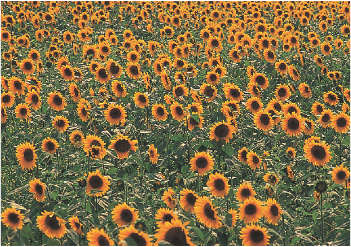
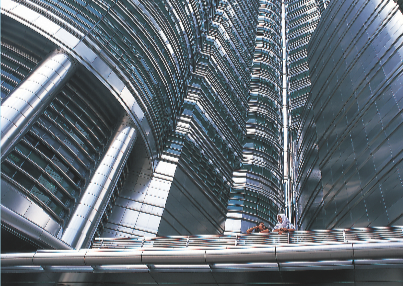
People as accent
Two women against the Petronas Towers, Kuala Lumpur. Shooting with a wide-angle lens makes the most of a strong contrast between people and environment.

Detail
The carved wooden door of an Italian church. Closing in on details extends the range of experience.
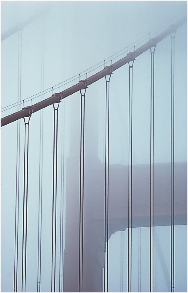
Abstraction
Fog over San Francisco’s Golden Gate Bridge gave an opportunity to create an abstract pattern from a detail of the structure, using a long (400mm efl) lens.
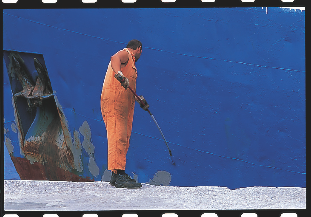
Isolating color
The attraction here was less the work going on than the classic color combination of orange and blue. Closing in on the scene to avoid the surroundings made the most of this.
Planning for special events
Parades, processions, fairs, and other public events offer some of the richest and most colorful possibilities for photography. There is never any shortage of scenes and people, and usually the only real difficulty is working your way around the crowds. Because of the high concentration of activity, the key to shooting comprehensively is planning. This means working things out well beforehand, and following a schedule, such as the following:
•The first step is finding out what events are on the calendar for the period you will be at your destination. Before you travel, check in guidebooks, and with the local, regional, or national tourist organization (website or telephone). If the event is well-known, such as Mardi Gras, look for previous photography in magazines such as National Geographic.
•Most events are organized, at least to some extent. If possible, find out what happens when from the organizers, or the local newspaper, local guides, or your hotel.
•Once you know the structure and timing of the event, you can decide which aspects of it are worth photographing, and whether you will have enough time to move from one place to another (in the case of a parade).
•Finding the right viewpoint is essential. In fact, for the key shot (there nearly always is one for most events), viewpoint is everything. Look around the site or the route to find the best vantage points.
•Somewhere high, like a balcony, is often a good bet, allowing you a variety of images with different lenses or zoom settings.
•One of the best ground-level views of a parade is head-on with a telephoto lens. A bend in the road or a traffic island are likely to be good positions for an unobstructed shot.

Blenheim cross-country
The cross-country event, featuring a water crossing and brush jump, at horse trials at Blenheim Palace, England. A position high on the opposite bank, recced earlier, gave a clearer view with a long telephoto (300mm efl) than from a viewpoint closer to the jump. Head-on shooting also made it easier to get a sequence of frames.
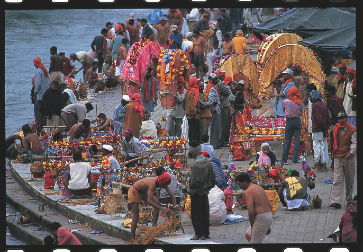

Fire Ceremony on the Ganges
Each sunset at the holy town of Haridwar on the Ganges in northern India, a Hindu ceremony is performed by priests swinging braziers. The event is always crowded, but a little research earlier in the day identified an area on the opposite bank as ideal for an unobstructed telephoto view. To get a water’s–edge position meant arriving an hour before

Kingston Carnival
The annual Carnival in the Jamaican capital is full of color and energy, best captured from the middle of the event. A talk with organizers established permission and also that there would be gaps between groups of dancers from where I could shoot toward the front of each
Photographing special events
Events offer several different kinds of image opportunity, and it’s important to keep all of these in mind. Most turn on one or two key moments, such as the high point of a procession, so always try and make sure you get these. Nevertheless, don’t ignore the other possibilities, which include the asides, the unpredictable events, and behind-the-scenes preparations. To cover as much as possible, you may need to make sure that you can move around, which may not be easy in heavy crowds.
Preparations in the lead up to an event, which may take a few hours, even days, always provide many good opportunities. During these times, which include rehearsals, the pressure is usually off, participants are less keyed-up, and you will usually have much better access than during the event itself. Immediately prior to a parade, participants will gather in one or more staging areas, and these too offer a particular kind of image.
Parades vary in style and organization from place to place, but there are usually some consistent features that lend themselves to these kinds of shot:
•Long-shot from head-on. Usually, this only works with the head of the parade or if there are distinct breaks between sections.
•Long-shot from above, cropped in and compressed, showing a mass of people.
•Wide-angle from close, taking in the energy and the crowd reaction.
•Close shot of the main character/ float/centerpiece. You may need to react quickly and choose the right focal length.
•Spectator reaction. Turn to look at the spectators. Their reactions can make good images in themselves.
•Details. Look for close-ups, even extreme, of costumes, uniforms, decorations, and so on. Some of these may be quite special and only brought out for this occasion.
Memory management
Events encourage heavy shooting, and with digital there are no concerns about wasting shots. The chief problem is having sufficient memory for the occasion. At the least, clear all your memory cards. In pauses during the day, when not much is happening, you could edit the images.

The Siena Palio
This violent and idiosyncratic horse-race takes place annually in the Tuscan city of Palio, dates back to the Middle Ages, and has not changed substantially in all that time. These four images are a small selection of the entire take, chosen here to illustrate variety and coverage. Preparation: Pageant participants (above) being checked for costume and makeup.

Acrobatics
A long pageant precedes the race proper.

The race
No saddles and hardly any rules as the horses complete several circuits of the track in the main piazza.

The crowd
As well as the event itself, turning your camera on the crowd can reward you with some spontaneous reaction shots.

Bull Fight
Taken with a medium telephoto lens, a shutter speed of 1/2 sec was used here to introduce significant blur. The intention was to convey the flow of action, rather than its bloodier details.
Photographing an arranged event
Events always need to be organized by someone, so if you’re taking your travel photography really seriously, with a view to selling images to an agency or a specific publication, why not arrange your own?
Now, organizing a situation for photography smacks of interference in the normal course of activity, with overtones of pretence. There is, however, the world of a difference between a setup that pretends to be real when it isn’t, and a performance that is simply dedicated to one camera. Travel photography is for the most part concerned with how things actually are, with a strong dose of documentary, and the idea of an out-and-out setup is anathema—where a photographer is trying to fool the audience into believing that here is a genuine, spontaneous slice of life when, in reality, the action has been stage-managed. But quite often, as we’ve seen, events are openly staged for people’s enjoyment, and the photographer’s usual problem is finding a vantage point for effective shots when there is an audience that also wants a good view of what is happening.
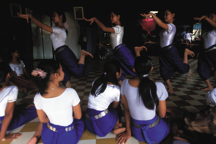

In this case, the performance in question was a traditional Khmer dance staged in the ruins of a 12th-century temple at Angkor, Cambodia. Specifically, and what made it interesting, the gallery where the dances occasionally took place was originally built for that, with stone friezes high up on the walls showing the medieval dancers. The events were arranged by the World Monuments Fund, responsible for the restoration of this particular Angkorean temple. I knew what I wanted—a scene as close to the original as possible. That meant no tourists in view and a certain amount of theatrical direction. It also meant hiring the troupe myself.
To get other shots, I visited the dance school in town and photographed rehearsals there. On the day, I knew from experience that makeup and other behind-the-scenes activities were likely to provide some spontaneous moments.
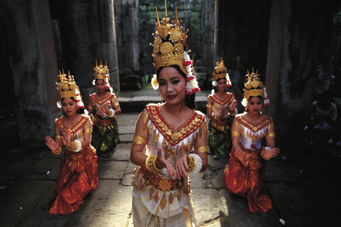

Traditional dance
These images are selected from a shoot at a 12th-century temple at Angkor, and at the dance school where the participants trained.
Dealing with obstructions
Popular sights attract people and are often under repair—it can be frustrating to find that the monument you planned to shoot is under scaffolding. Time was when you would have to resign yourself to the loss of a picture. Digital imaging, however, provides the means to restore a scene, and most people are already familiar with the cloning and retouching tools in image-editing software. Here is not the place for detailed instruction in image retouching—the important thing when photographing an obstructed view is to know what can be done digitally and how to shoot for it.
Think of obstructions in terms of their removability, which varies. If the obstruction is at some distance from your subject, it may be possible to move right up to it and shoot wide-angle. Alternatively, a power line that hangs right in front of you from your first choice of viewpoint may, from a distance, reduce to insignificance or be hidden by something innocuous like trees.
When you’ve done your best on the ground, it’s time to plan for the digital retouching. In nearly all cases, removing obstructions digitally means cloning from elsewhere in the image, so these clone sources are the parts to think about. A patterned surface, such as brickwork, is relatively easy to use, but check carefully what the obstruction is covering. If it is hiding a unique feature, such as the doorway of a building, then consider moving the camera slightly. The principle is to choose the viewpoint so that, as far as possible, only clonable areas are hidden.
Even more effective is the parallax system for retouching. For this to work, there has to be some distance between obstruction and subject, so that shifting the viewpoint to one side actually has a parallax effect, revealing unobstructed parts. Scaffolding built close to a building responds poorly to this technique. The ideal result is a pair of near-identical images, but with the parts that are obscured in the first shot revealed in the second. The digital technique is then straightforward; it consists of placing one image in a layer over another and erasing selectively.


1. A constant crowd: This Roman monument at Ephesus, Turkey, was immensely popular. I spent ten minutes shooting the identical framing several times.
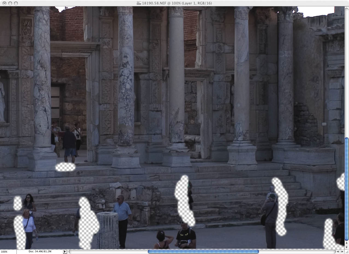

2. Layered removal: Placing each image in a stack, the people were removed with an eraser brush.Because they were moving, what was obscured in one layer was visible in another.

3. Flattened composite: The holes in each layer created by people removal were automatically filled by the revealed parts of the monument in another layer, and the final composite shows an emptied site.